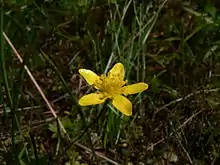Ranunculus occidentalis
Ranunculus occidentalis, the western buttercup,[1] is a species of buttercup found in the western regions of North America. Its distribution extends from Alaska through British Columbia and Alberta to central California.[1] The flower can be seen in open meadows, forests, and other generally flat areas up to an elevation of 2,200 metres (7,200 ft).[2]
| Ranunculus occidentalis | |
|---|---|
 | |
| R. occidentalis in Anacortes, Washington | |
| Scientific classification | |
| Kingdom: | Plantae |
| Clade: | Tracheophytes |
| Clade: | Angiosperms |
| Clade: | Eudicots |
| Order: | Ranunculales |
| Family: | Ranunculaceae |
| Genus: | Ranunculus |
| Species: | R. occidentalis |
| Binomial name | |
| Ranunculus occidentalis | |
Aleut first nations may have used juice from the plant as a poison,[3] its toxicity arising from the substance protoanemonin.[4] Shasta first nations coincided blooming Ranunculus occidentalis with salmon runs in the summer.[5] The seeds were used to make pinole, a staple food.[6]
This plant is similar to, and sometimes difficult to distinguish from, the California buttercup (Ranunculus californicus).
| Wikimedia Commons has media related to Ranunculus occidentalis. |
References
- "Ranunculus occidentalis". Natural Resources Conservation Service PLANTS Database. USDA. Retrieved 18 October 2015.
- "Jepson Manual Treatment for Ranunculus occidentalis". University of California Berkeley Jepson Treaments. Retrieved 2009-06-05. External link in
|publisher=(help) - Flora of North America
- Bank, Theodore (1953). "Botanical and ethnobotanical studies in the Aleutian Islands - Health and Medical Lore …". Michigan Academy of Science, Arts and Letters: 428. Cite journal requires
|journal=(help) - Holt, Catharine (1946). "Shasta Ethnography". University of California, Berkeley: 310. Cite journal requires
|journal=(help) - Ethnobotany